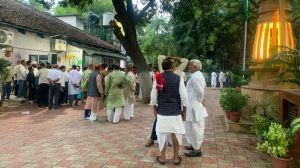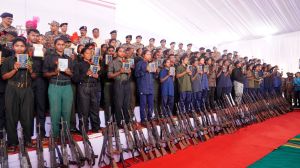In Manipur, it’s either the militants’ way or the national highway
Twenty-four hours after Home Minister Shivraj Patil announced in Parliament that security forces have been asked to end the blockade of the ...

Twenty-four hours after Home Minister Shivraj Patil announced in Parliament that security forces have been asked to end the blockade of the national highways in the state, Manipur was still waiting.
In fact, the Government’s indifference can be gauged from the fact that NH-53, believe it or not, has been under the control of various underground outfits for over seven years.
Ask any Army officer about how the security forces finally ‘recovered’ and reopened NH-53 that links Imphal with the rest of India — via Assam’s Barak Valley and Meghalaya — from the grip of militant groups, you get a chilling account.
The security forces in Manipur, where there are over 20 different underground armed outfits, have no hesitation to admit this fact. ‘‘The NH-53, from Jiribam to Kaiphundi, had been under underground domination for over seven years,’’ says Maj Gen GG Dwivedi, GOC of the 57 Mountain Division engaged in counter-insurgency operations here.
The question that no one is willing to answer is why no action was taken for such a long time. The Border Roads Organisation (BRO), a wing of the Army that was supposed to maintain the 225-km stretch between Imphal and Jiribam, had stopped work when a superintending engineer and several other personnel were kidnapped by militants in October last year. That had made the Army admit that ‘‘the fear of extortion and kidnapping had prevented construction activities on this vital lifeline.’’
But it was only when the All Naga Students’ Association of Manipur (ANSAM) launched an economic blockade on the two highways — NH-39 and NH-53 — on June 19 that everybody woke up to consider reopening of NH-53. And that too happened only when Manipur Chief Minister Okram Ibobi Singh found that it was not easy to ensure safe passage of traffic on NH-39, which links the state with Assam through Nagaland, because various groups in Nagaland had already extended their support to the ANSAM blockade. So, he had to make a formal request to security forces to clear NH-53.
Brig SS Rana of the 57 Artillery Brigade too has claimed to have ‘‘pushed back’’ cadres of the NSCN(K) and United National Liberation Front (UNLF) from a 40-km stretch between Jiribam and Kaiphundi, neutralizing 49 IEDs on the route. Similarly, Assam Rifles has said it had smashed an NSCN(IM) hideout located about 30 km from its operational HQ at Nungba.
Thanks to pressure from the Chief Minister, the security forces have now set up 15 new posts along the 225-km stretch of NH-53 between Imphal and Jiribam. ‘‘With the BRO pressing into service over 500 labourers and the Army and Assam Rifles extending support, NH-53 is now free from the grip of militants,’’ says Lt Col S D Goswami, Defence PRO here.
Even before the present operation to clear NH-53, the Army was operational in three of the state’s five hill districts — Churachandpur, Bishenpur and Chandel — taking six months to clear the ‘‘liberated zone’’ declared by the armed rebels. The Army also destroyed 35 IEDs laid along the roads in that operation and claimed that the UNLF had suffered a lot in this operation.
Also cleared was Henglep, a town that was under siege of another outfit, MPLF, for six years. Such was the situation that the administration had virtually withdrawn. It was only after the Army cleared the ‘‘siege’’ that the administration started functioning.
(Tomorrow: Ibobi plank of good governance is empty rhetoric)






- 01
- 02
- 03
- 04
- 05

























